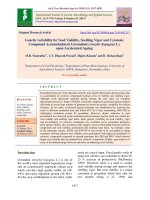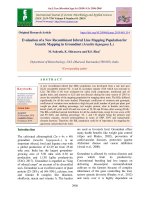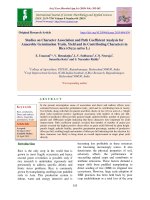Genetic diversity studies in yield and its contributing traits in Groundnut (Arachis hypogaea L.) genotypes using D2 statistics
Bạn đang xem bản rút gọn của tài liệu. Xem và tải ngay bản đầy đủ của tài liệu tại đây (359.72 KB, 7 trang )
Int.J.Curr.Microbiol.App.Sci (2019) 8(6): 32-38
International Journal of Current Microbiology and Applied Sciences
ISSN: 2319-7706 Volume 8 Number 06 (2019)
Journal homepage:
Original Research Article
/>
Genetic Diversity Studies in Yield and its Contributing Traits in Groundnut
(Arachis hypogaea L.) Genotypes using D2 Statistics
Shruti Koraddi1*, V. Satyanarayana Rao2, M. Girija Rani3, B. Sreekanth4,
V. Manoj Kumar5 and Nafeez Umar6
1
Department of GPBR, 4Department of Crop Physiology, 5Plant Pathology, 6Department of
Statistics and Mathematics, Agricultural College, Bapatla, ANGRAU, A.P., India
2
ADR, Lam, Guntur, ANGRAU, A.P., India
3
RARS, Maruteru, A.P., India
*Corresponding author
ABSTRACT
Keywords
D2 statistics,
Groundnut, Cluster,
Yield, Cluster
distance and
Percent of
contribution
Article Info
Accepted:
04 May 2019
Available Online:
10 June 2019
An experimental trial consisting of 40 groundnut genotypes, study was conducted during
kharif, 2017 at Agricultural College Farm, Bapatla, to study the genetic divergence in
different characters with yield and yield related traits. The genetic diversity among 40
genotypes for 15 characters was estimated by employing D² statistic. The 40 groundnut
genotypes were grouped under seven clusters. Among seven clusters, cluster I was the
largest which comprising of 26 genotypes fallowed by clusters II with nine genotypes. The
rest of clusters like III, IV, V, VI and VII had shown solitary in nature. The average D2
values of inter cluster distances, showed maximum distance between Cluster-IV and VI
(819.41) followed by inter cluster distance (732.17) between IV and VII. It indicates that
crossing between these clusters helps in production of transgressive segregates or better
recombinants. Each character had their own contribution to total divergence where, the Oil
content and protein content had maximum contribution of 38.59% and 30.39%
respectively to the divergence of genotypes.
subtropical regions of the world it is an
important oilseed crop. In India most of the
farmers considered Groundnut as the most
remunerative crop with relatively less chance
of crop losses despite an unpredictable
monsoon. In North coastal zone farming
community of Andhra Pradesh, Groundnut is
gaining popularity and farmers are growing
groundnut by practicing high input
management and is being cultivated
Introduction
Oil and fats are essential things in human diet
since they supply energy; improve taste and
palatability of food. Oilseed crops next to
cereals in respect to production of agricultural
commodities in India, Oilseeds occupy a
place of prime importance in Indian economy.
Groundnut (Arachis hypogaea L.) is a leading
oilseed crop in India. In tropical and
32
Int.J.Curr.Microbiol.App.Sci (2019) 8(6): 32-38
throughout the year viz., Kharif, Rabi and
Summer season.
mature pods per plant, pod yield per plant (g),
harvest index, shelling percentage, kernel
yield per plant(g), hundred kernel weight(g),
oil content (%), protein content(%), oil
yield/plant(g) and hundred pod weight(g).
Except days to 50% flowering and days to
maturity data were recorded on the plot basis.
The genotypes were grouped into different
cluster by using the Tocher’s method.
Average intra (diagonal) and inter-cluster
distance and Cluster mean values for various
yield and yield attributing characters. The
relative contributions of different characters
towards genetic divergence were also worked
out.
Genetic diversity is the first and foremost
thing for any crop improvement programme.
For finding the gene source for the particular
trait within the available germplasm, the
evaluation of genetic diversity present in the
trait is very important. So, it is pre-requisite to
know the genetic diversity of the existing
genotypes before conducting any crop
improvement programme. To assess the
genetic diversity present among the genotypes
Mahalanobis (1936) D2 technique is widely
used in crop improvement programmes.
Therefore, the present study was carried out
to evaluate 40 groundnut genotypes for the
nature and magnitude of genetic diversity
present in it.
Results and Discussion
The genetic diversity among 40 genotypes for
15 characters was measured by using D²
statistic. Based on D² values, the genotypes
were clustered using Tocher’s method as
given by Rao (1952).
Materials and Methods
An experimental study was carried out at the
Agricultural college farm, Bapatla using 40
diverse genotypes obtained from various
research stations which were located across
Andhrapradesh viz., Agricultural Research
Station, Kadiri, RARS Tirupati and RARS
jagityal. The list of genotypes together with
their pedigree and origin is presented in table
1. The experimental field is laid out in
randomized block design with three
replications during the year kharif 2017. The
experiment had plot size of 4 x 1.2 m2 of each
genotype having 3 rows. Row to row 30cm
and plant to plant 10 cm distance were
maintained. At regular intervals weeding was
carried out, and Earthing up operation was
taken up after gypsum application. All the
recommended practices were followed to
raise a healthy crop. The following
observations were recorded on five randomly
selected plants per replication for each
genotype for all the 15 characters viz., Days to
50 % flowering, Plant height(cm), SPAD
chlorophyll meter reading (SCMR) at 60 DAS
and 80 DAS, days to maturity, number of
Group constellation
Based on the D2 statistics 40 groundnut
genotypes were grouped into seven clusters
(Table 2 and Fig. 1) by using Tocher’s
method. The distribution of genotypes into
seven clusters is presented in table 2. Among
seven clusters, cluster I was the largest
comprising of 26 genotypes fallowed by
clusters II with 9 genotypes. The cluster III,
IV, V, VI and VII are solitary in nature.
Intra and inter relation of clusters
The average D2 values of intra and inter
cluster distances are given in table 3 and
figure 2. Maximum difference among the
genotypes within the same cluster was shown
by cluster-I (80.78) and fallowed by cluster II
(66.65). Some clusters like III, IV, V, VI and
VII intra cluster value was zero due to solitary
nature.
33
Int.J.Curr.Microbiol.App.Sci (2019) 8(6): 32-38
Table.1 List of Genotypes together with their pedigree and origin
Sl. No
1
Genotypes
kadiri 6
Pedigree
JL24 X AH316 S
Origin
ARS Kadiri
2
3
kadiri 7 Bold
Kadiri 8 Bold
ICGV86522 X ICGVFDRS X ICGV 91172
ICGV86522 X ICG 10 X ICGV 91172
ARS Kadiri
ARS Kadiri
4
5
kadiri 9
kadiri Harithandra
K-4 X Vemana
91-57-2 X P1-47-6177
ARS Kadiri
ARS Kadiri
6
7
K 1454 red
K 1501
Vemana X Tirupai
K-4 X ICGX 930179 P2
ARS Kadiri
ARS Kadiri
8
9
K1574
K1609
Vemana x JSSP-6-VB
K-8 X JL-24
ARS Kadiri
ARS Kadiri
10
11
K1621
K1715
ICGV99099 X K-4
Germplasm collections
ARS Kadiri
ARS Kadiri
12
13
K1719
K1725
K-7 X TAG 24
K-7 X TAG 24
ARS Kadiri
ARS Kadiri
14
15
K1735
K1787
K-7 X JL 24
ICGX020063-F2-B1-SSD-P23-B2
ARS Kadiri
ARS Kadiri
16
17
K1789
K1800
ICGX020066-F2-B1-SSD-P2-B1
ICGV96176(Floriant X 2597447 XICGV88312)
ARS Kadiri
ARS Kadiri
18
19
K1805
K1811
ICGV020047-F2-SSD-SSD-P18-B1
ICGV020055-F2-SSD-SSD-P18-B1
ARS Kadiri
ARS Kadiri
20
21
K1812
K1813
ICGV020055-F2-SSD-SSD-P20-B1
ICGV020055-F2-SSD-SSD-P25-B1
ARS Kadiri
ARS Kadiri
22
23
K1847
K1924(VGLS)
K-8 X K-4
VG9521 X R 8808
ARS Kadiri
ARS Kadiri
24
25
26
27
28
29
30
31
K1924(SB)
K2014
K2064
K2066
K2075
K2077
K2104
TCGS1416
VG9521 X R 8808
K-9 X 3 X 155-005
K-7 X K-4
K 1468 X K-4
K-7 X TKG 19-A
K-7 X ICGV99073
K-8 X ICGV99073
Germplasm collections
ARS Kadiri
ARS Kadiri
ARS Kadiri
ARS Kadiri
ARS Kadiri
ARS Kadiri
ARS Kadiri
RARS, Tirupati
32
33
TCGS1426
TCGS1073
Germplasm collections
Germplasm collections
RARS, Tirupati
RARS, Tirupati
34
35
36
37
38
39
40
41
42
TCGS894
TCGS1157
Dharani
Narayani
Abhaya
TAG 24
JCG-88-2
Girnar-3
Girnar-2
Germplasm collections
Germplasm collections
VRI 2-XTCGP-6
JL-24 x Ah316/s
K-134XTAG-24
TGS-2 X TGE-1
J 11 x TG (E) 1
Girnar 1 x ICGS 11
M 13 x R 33-1
RARS, Tirupati
RARS, Tirupati
RARS, Tirupati
RARS, Tirupati
RARS, Tirupati
BARC Trombay, Mumbai
RARS,Jagityal
DGR, Junagadh
DGR, Junagadh
34
Int.J.Curr.Microbiol.App.Sci (2019) 8(6): 32-38
Table.2 Distribution of 40 Groundnut genotypes in different clusters based on D2 statistics
Clusters
No of
genotypes
26
Genotypes
Cluster. II
9
Cluster. III
1
K1574, K1621, K 1501,Kadiri 8 Bold, K1735, kadiri 7 Bold, JCG-88-2, K2077, K1847,
K2104, K2014, K2075, K1609, K2064, K1715, K1725, TCGS1157, Dharani, kadiri 9,
K1811, K1800, K1924(VGLS), Narayani, K1813, TCGS1416, K1789.
TCGS1426, Abhaya, TAG 24, K1812, K1805, K1787, kadiri 6, kadiri Harithandra, K 1454
red
TCGS1073
Cluster. IV
Cluster. V
1
1
TCGS894
K1924(SB)
Cluster. VI
Cluster. VII
1
1
K2066
K1719
Cluster. I
Table.3 Average intra (diagonal) and inter-cluster distance of 40 Groundnut genotypes
Clusters
Cluster. I
Cluster. I
Cluster. II
Cluster. III
Cluster. IV
Cluster. V
Cluster. VI
Cluster. VII
80.78
150.87
168.18
412.16
198.60
269.49
317.47
66.65
166.65
196.02
165.76
332.43
280.37
0.00
190.90
106.99
589.98
618.81
0.00
185.46
819.41
732.17
0.00
668.87
619.74
0.00
107.70
Cluster. II
Cluster. III
Cluster. IV
Cluster. V
Cluster. VI
0.00
Cluster. VII
Table.4 Cluster mean values for various yield and yield attributing characters
Character
Cluster. I
Cluster. II
Cluster. III
Cluster. IV
Cluster. V
Cluster.VI
Cluster. VII
DFF
27.12
25.96
25.33
26.33
24.67
29
26
PH
NPP
45.67
28.71
48.21
28.42
44.33
15.53
35.53
22.67
55.60
48.80
48.07
38.47
48.40
21.27
Pod Yield/Plant(g)
HI
30.64
0.53
26.18
0.50
19.23
0.65
24.07
0.70
31.50
0.38
40.37
0.53
25.33
0.62
100 Pod Weight(g)
Protein content (%)
111.12
25.95
91.20
24.89
101
25.90
101.83
23.70
88.17
25.20
126.33
25.90
118.83
25.20
Oil content (%)
SHP
46.29
67.85
46.30
66.68
48.10
70.88
48.30
73.85
48.40
64.51
43.40
68.72
43.50
71.74
DM
SPAD@60 DAS
112.81
50.69
107.93
50.66
107.67
53.40
107.67
54.73
109.33
54.87
114
50.03
107.33
49.30
SPAD @80 DAS
KY/Plant
Oil Yield/Plant
49.39
9.63
445.73
47.29
8.39
386.19
49.80
3.06
147
53.60
5.50
266
54.67
16.42
794.67
52.17
15.67
680
52
5.37
233.33
50.34
40.73
56.77
42.50
43
64.50
62
100 KW
DFF=Days o 50% flowering, PH=plant height (cm), NPP= No. of mature pods per plant, HI=Harvest index,
SHP=shelling percentage, DM=Days to maturity, KYP=Kernal yield per plant (g), 100KW=100 Kernal weight
35
Int.J.Curr.Microbiol.App.Sci (2019) 8(6): 32-38
Table.5 Relative contribution of 15 traits towards divergence in groundnut genotypes
Source
Days o 50% flowering
Plant Height (cm),
No. of mature pods per plant
Kernel Yield /Plant
Pod Yield/Plant
Harvest Index
100 Pod Weight(g)
Oil content (%)
Protein content (%)
100 Kernel Weight(g)
Oil Yield/Plant(g)
SPAD @60 DAS
SPAD@80 DAS
Shelling Percenage(%)
Days to maturity
Total
Contribution %
0%
0.13%
2.05%
0.13%
0.13%
0%
0%
38.59%
30.38%
1.15%
0.77%
0%
0.77%
0%
25.9%
100
Times ranked 1st
0
1
16
1
1
0
0
301
237
9
6
0
6
0
202
Fig.1 Clustering of 40 groundnut genotypes by Tocher’s method
36
Int.J.Curr.Microbiol.App.Sci (2019) 8(6): 32-38
Fig.2 Average D2 values of intra and inter cluster distances
Cluster-IV and VI showed maximum inter
cluster distance (819.41) followed by inter
cluster distance (732.17) between IV and VII
(Table 3). These clusters are quite divergent
from each other and the genotypes belonging
to these clusters can be used as parents for
hybridization programme as crosses between
genotypes belonging to the clusters with
maximum inter cluster distance, may give
better recombinants. The lowest inter cluster
distance (106.99) was noticed between
cluster-III and V. Similarly Dhakar et al.,
(2017) and Namrata et al., (2018) also
reported relatively low genetic diversity with
respect to morphological characters in peanut.
presented in (Table 4). All the 40 genotypes
were spread over seven clusters and means of
each character in each cluster were scored for
all the seven clusters for all the 15 characters.
Cluster means were found highest for
different characters viz., Cluster V showed
highest mean performance for oil yield per
plant (794.67), No. of mature pods/plant
(48.80), plant height (55.60), days to maturity
(109.33), SPAD @ DAS (54.87), SPAD @80
DAS (54.67), Kernel yield per plant (16.42)
and cluster VI showed highest mean
performance for Days to 50% flowering (29)
pod yield per plant (40.37), 100 pod weight
(126.33), 100 kernel weight (64.50) for
harvest index (0.70) and shelling percentage
(73.85) cluster IV showed highest. Cluster I
showed highest for protein content (25.95).
Cluster means
The cluster means for 15 characters and over
all character wise across the seven clusters are
37
Int.J.Curr.Microbiol.App.Sci (2019) 8(6): 32-38
Contribution of different
towards divergence
cluster mean helps in development of
transgressive
segregants
or
better
recombinants.
characters
Difference in proportion of contribution of
each character to total D2 statistics was
observed and presented in table 5. The Oil
content contributed 38.59 per cent to the total
divergence of genotypes followed by protein
percentage (30.38%), days to maturity
(25.9%), number of mature pods per plant
(2.05%), 100 Kernel Weight (1.15%), both
Oil Yield/Plant (g) and SPAD@80 DAS
(0.77) respectively, similarly the traits like
Kernel Yield /Plant, Plant Height and Pod
Yield/Plant (0.13). contributed to the
divergence. Some of the characters like days
to 50% flowering, SPAD @60 DAS, 100 Pod
Weight(g), Harvest Index, shelling percentage
not shown their contribution to total
divergence. These observations were in
accordance with observations of Foundra et
al., (2000) and Hampannavar and Khan.
(2018).
References
Dhakar, T.R., Sharma, H., Namrata and
Bisen,
P.2017.Genetic
Diversity
Analysis in Groundnut (Arachis
hypogaea L.) Genotypes using D2
Statistics. Indian Journal of Ecology.44
(4): 175-181.
Foundra MZ, Harnande R, Lopez L, Ravelo I.
Analysis of variability in collected
peanut. Legume, Res. 2000; 13:9-13.
Hampannavar, M.R and Khan, H.2018.
Analysis of genetic diversity of
groundnut (Arachis hypogaea L.)
genotypes collected from various parts
of India. Journal of Pharmacognosy
and Phytochemistry; 7(2): 1100-1103.
Mahalanobis PC. On the generalized distance
in statistics. Proc. Natn. Inst. Sci. India.
1936; 2: 49-55.
Namrata, Sharma, H., Bisen, P., Singh, B and
Jain, S.2018. Assessment of Genetic
Diversity among Groundnut (Arachis
Hypogaea L.) Genotypes. International
Journal of Bio-resource and Stress
Management. 9(3): 383-386.
Rao CR. Advanced Statistical Methods in
Biometric Research. John Wiley Sons,
New York, 1952, 390.
In conclusion, the diversity is prerequisite for
hybridization
programme.
Genotypes
belonging to clusters separated by high
genetic distance may be used in hybridization
program to obtain a wide spectrum of
variation. The most of times selecting parents
only based on phenotype won’t give the
expected result. The selections of parents
based on intra and inter cluster distance and
How to cite this article:
Shruti Koraddi, V. Satyanarayana Rao, M. Girija Rani, B. Sreekanth, V. Manoj Kumar and
Nafeez Umar. 2019. Genetic Diversity Studies in Yield and its Contributing Traits in
Groundnut (Arachis hypogaea L.) Genotypes using D2 Statistics. Int.J.Curr.Microbiol.App.Sci.
8(06): 32-38. doi: />
38
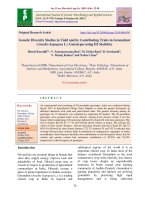
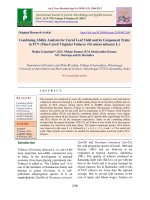
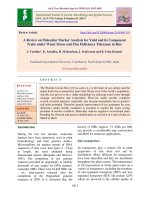
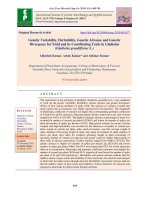
![Genetic variability studies in F2 segregating populations for yield and its component traits in Okra [Abelmoschu sesculentus (L.)Moench]](https://media.store123doc.com/images/document/2020_01/13/medium_nxs1578931693.jpg)

